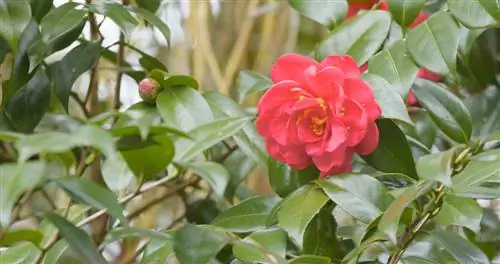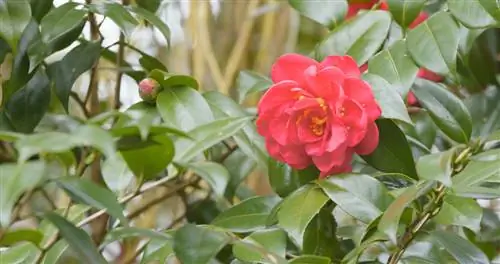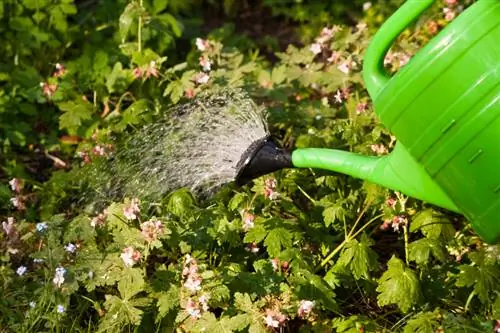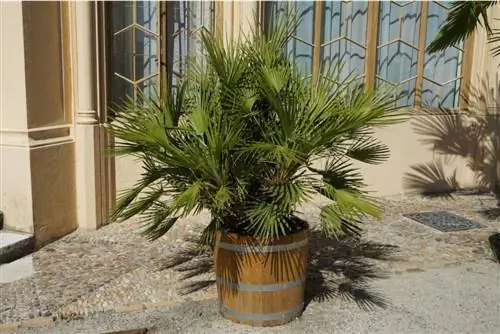- Author admin [email protected].
- Public 2023-12-25 17:45.
- Last modified 2025-01-23 11:21.
Camellias are large-flowered ornamental plants with special requirements. The care is a little more complex, but if you pay attention to the location and care requirements, you can enjoy the long-lasting plant for many years. Some camellias live for several hundred years.

What are camellias and how to care for them?
Camellias are large-flowered, evergreen ornamental shrubs native to eastern Asia. They prefer partially shaded locations, humus-rich, lime-poor soils and moderate moisture. Camellias are popular in Europe as potted plants, are also cultivated outdoors in mild regions, and can live for several hundred years if well cared for.
Origin
Camellias are part of the tea bush family. The genus includes around 300 species including Camellia japonica, which is preferably cultivated as an ornamental plant. It is related to the tea bush, also known as Chinese camellia or Camellia sinensis. This species has been cultivated as a crop in East Asia for more than 4,000 years and is used for the production of green and black tea.
Camellias grow in eastern Asia, with a center of biodiversity in southern China. In Europe, various large-flowered camellia species reached their fashion peak in the 19th century.
Growth
The Japanese camellia is a long-lived and evergreen shrub. There are plants whose age is more than 1.000 years is estimated. The species can also grow tree-shaped and reach heights of between six and eleven meters in its natural habitat. In mild regions, the shrub can grow up to four meters high in the garden. Young branches have grayish to brown bark, which turns purple-brown in the second year.
leaves
The foliage of camellias is arranged alternately. The leaves are simple and sit on stems that are five to ten millimeters long. Its leaf blade appears leathery and is elliptical in shape. They are colored dark green above, while the underside appears light green and is spotted with brown. A raised central vein in a yellowish-green color runs through the leaf blade.
Bloom
Short-stemmed flowers emerge from the leaf axils. They grow singly or in pairs and can grow up to 15 centimeters tall. They are borne by nine bracts and sepals that are colored green. The crown consists of six to seven or more outer and five inner petals. At the center of the flowers, which are reminiscent of peonies, are striking stamens. They are yellow in color and form an aesthetic contrast to the flower crown.
Flowering time
In the natural location, camellias bloom between January and March. Cultivated varieties open their flowers in late winter. The flowering period extends into spring. The flowers shine in white, pink or red.
Fruit
In autumn, camellias develop woody and spherical capsule fruits. They consist of three compartments, in each of which one or two seeds ripen. Fruit ripening occurs between September and October.
Usage
Camellias are planted in pots because they usually don't survive the winter months outdoors. In regions with mild winter temperatures, the trees can be planted in the garden. The shrubs decorate ventilated winter gardens, terraces or balconies as potted plants. They set blooming and colorful accents in Japanese gardens. In the garden, camellias are traditionally used as solitary shrubs. Magnolias, rhododendrons, bamboo and Japanese maple have proven to be ideal companion plants.
Is camellia poisonous?
Camellia japonica is considered non-toxic to humans, dogs, horses and cats. The Camellia sinensis shrub, which is used to make tea, contains caffeine in the plant parts. If a person consumes large amounts of the leaves, they may experience an increased heart rate or palpitations. Cramps are also possible.
Which location is suitable?
Camellias prefer a partially shaded location under taller trees. If you want to plant your camellia in the garden, you should offer the shrub a mild and wind-protected location. Especially during the summer months, the trees need sufficient light to stimulate bud formation. The winter sun damages the plant as it can lead to drought stress.
In the pot, the shrubs like to grow on shady balconies and terraces. They can be cultivated in winter gardens as long as they are not heated and are well ventilated. The bushes like temperatures between twelve and 16 degrees Celsius. Therefore they are not suitable for heated interiors.
What soil does the plant need?
The tea bush family likes humus-rich, lime-poor soil with slightly acidic conditions. Moorbed or rhododendron soil is ideal for cultivation. Sharp sand or lava grit improves permeability so that irrigation water can drain away better. At the same time, the roots have better growing conditions. Camellias prefer slightly moist conditions, but there should be no waterlogging.
Mix the substrate yourself:
- six parts peat or peat substitute
- two parts compost
- one part of expanded clay
- a part of sand
What is the best time to plant?
Spring planting has proven to be effective because the shrubs have enough time to take root during the vegetation phase. This ensures that the plants survive the winter better. Loosen the soil and dig a large planting hole. Place gravel or grit on the ground to ensure water drainage. Place the root ball in the hole and fill the gaps with rhododendron soil or leaf humus.
Sowing
Camellias require warm temperatures to successfully develop fruit. The Japanese camellia also develops capsule fruits in cooler regions, which can be harvested between September and October for seed propagation. Since the seeds quickly lose their ability to germinate in dry conditions, they must be sown immediately or stored in a cool, moist place.
The seeds are scattered on nutrient-poor substrate and moistened. A film ensures that the humidity remains high. In a warm place, the seeds will germinate within a few weeks. A camellia propagated from seeds needs between four and 20 years until it develops flowers for the first time.
Cuttings
The tea bush plants can be propagated via cuttings. Use nutrient-poor substrate for cultivation. Make sure the soil moisture is constant. A transparent cover serves as evaporation protection. The planter is placed in a bright and partially shaded place. Underfloor heating provides ideal conditions. It can take several months for cuttings to form roots.
Head cuttings
With this propagation method, you cut branches about 15 centimeters long from a he althy mother plant. The shoot should be he althy and have at least three leaves.
Shoot cuttings
They represent a special form of head cuttings. With them, the tip of the shoot of the head cutting is cut off because it is insufficiently mature and would bend during growth. Below the break point, the plant forms fresh branches so that it grows compactly. Shoot cuttings should have two to three leaves.
Leaf cuttings
Leaves are preferred for propagation because they reliably develop roots. It is placed in the substrate with the stem at a slight angle. As soon as roots have formed, the camellia will sprout again. The old leaf dies over time.
Node cuttings
In this special method, a leafy piece of camellia shoot with a length of two to three centimeters is used for propagation. It must have a well-developed eye so that the cutting can sprout. Roll up the leaves and secure with a rubber band or raffia. In this way evaporation is reduced. Push a small piece of wood into the rolled leaf to give it more stability. Place the cutting horizontally on a nutrient-poor substrate.
Camellias in pot
The bucket should be slightly larger than the root ball. If small camellias are planted in pots that are too large, the unrooted substrate quickly becomes waterlogged and compacts. The fine roots can no longer spread optimally and are exposed to the risk of waterlogging. Acidification can also occur, which weakens the plant's vitality.
Tips for potted plants:
- Place the pot on feet so that water can drain away
- Putting camellias outside during the summer
- Water shrubs in shallow containers more often than plants in tall containers
Watering camellias
Camellias like slightly moist conditions. The root ball should not dry out or be too wet. During the growth phase between spring and autumn, the shrubs are watered regularly. Potted plants require more frequent watering because the substrate dries faster.
Excess water should be removed from the coaster immediately. The top layer of soil is allowed to dry slightly between waterings. Use rainwater, because tap water contains a lot of lime and is harmful to plants. Mist the leaves with water occasionally when the air is very dry.
Fertilize camellias properly
The tea bush plants enjoy regular fertilizer applications. Give the bushes a liquid fertilizer (€6.00 on Amazon) for green plants every two weeks. Alternatively, you can supply the bushes with a long-term mineral fertilizer in powder form in spring. This is distributed on the substrate before the leaves emerge. If you are applying an organic fertilizer, you should fertilize again in May.
The plants tolerate rhododendron fertilizer or guano. You can halve the amount recommended on the package. Camellias have high nitrogen requirements. At the same time, they are sensitive to s alt. Balcony flower fertilizers are not suitable because they contain a lot of phosphate and little nitrogen.
Cut camellias correctly
Camellias are well tolerated by pruning and can withstand even more severe pruning without any problems. Since the bushes become more beautiful with age, only young plants need to be trimmed regularly. Below the interfaces, the plants sprout new shoots and develop good branches and bushy growth forms. The best time for pruning is before the leaves emerge in spring.read more
How do I transplant correctly?
Camellia japonica and its relatives are repotted between May and July or in autumn. During spring, outdoor shrubs can be dug up and transplanted. Container plants need a larger pot every two to three years. At the latest when the roots are visible on the surface of the substrate, the plants will enjoy a new pot.
Wintering
Camellias are sensitive to frost because of their evergreen leaves. In mild regions on the coasts and lowlands, the plants survive the winter outdoors with appropriate winter protection. They should be placed in a location that is not exposed to wind or sun.
Older plants, which have had more time to take root than younger shrubs, are less sensitive to low temperatures. They can survive outdoors down to -15 degrees Celsius if the root ball and leaves are covered. Potted plants are frost hardy down to -5 degrees Celsius. Late frosts pose a risk because the plants are already sprouting and the delicate tissue freezes immediately.
The perfect winter protection for outdoor camellias:
- spread a thick layer of mulch on the ground
- Shade leaves with a light fleece
- Wrap the tub with foil and place it on wooden boards
- water on frost-free days
Winter quarters
Potted plants should be overwintered in an unheated room with temperatures up to a maximum of 15 degrees Celsius. Heated living rooms are not suitable because the plants do not go into hibernation if the temperatures are too high. Next year the number of flowers will be sparse. The location ideally offers bright conditions. During the rest phase, the nutrient supply is stopped. Keep the plants a little drier. The root ball should not dry out completely.
Diseases
The camellia plague has been spreading in Europe for several years. The highly infectious disease is difficult to combat. You can recognize a disease by the brown-red discoloration of the flowers, which begins in the center and progresses outwards. A mold-like coating often appears. Varieties with bright flowers are more susceptible to the disease. If you discover damage to your plant, the affected areas should be removed and disposed of with household waste.read more
Pests
Camellias are often attacked by pests when they are weakened. To prevent an infestation, you can regularly give your plant a plant decoction. Horsetail and nettle extracts increase vitality.
Bigmouth Weevil
The beetles are nocturnal and eat typical structures in the leaves. They lay their eggs on the substrate. After hatching, the larvae bore into the soil and damage the roots. Nematodes have proven to be a successful control measure. Beetles can be collected at dusk.
Scale and mealybugs
These pests often occur when the camellias are in winter quarters that are too dry and warm. They spread to all parts of the plant and usually settle in one place. During the sucking activities, the pests inject poison into the plants, which negatively affects growth.
Place the plant in a bright location and ventilate regularly so that the air does not become too dry. Although camellias need a lot of nitrogen, over-fertilization can promote the spread of pests.
Fungal infestation
Cancerous growths indicate a fungal disease that is causing the plant to die. Affected parts should be cut off immediately so that the spores cannot spread further. Little is known about this disease, known as camellia dieback.
Tip
When buying camellias in the store, you should choose bushes with as few buds as possible. The plants react sensitively to the change of location between the nursery and the home. Transport quickly causes the bushes to drop their buds.
Varieties
- Polar Ice: Medium growth, upright shrub. Hardy down to -20 degrees Celsius. Flowers white.
- Winter’s Dream: Upright growth with loose branches. Hardy down to -20 degrees Celsius. Flowers semi-double, pink.
- Fire N Ice: Compact growing shrub. Hardy down to -20 degrees Celsius. Flowers dark orange-red in color.






